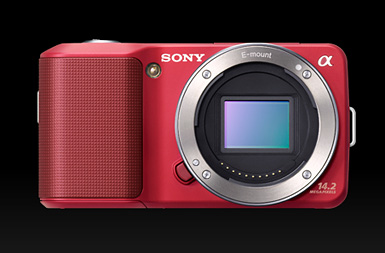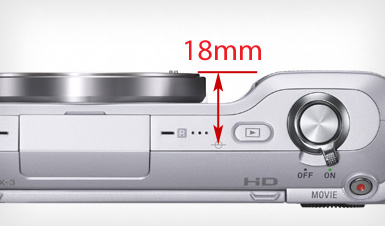Sony: Less EVIL Than Feared
May 11, 2010
Well, the much-anticipated “EVIL” cameras from Sony have finally arrived, the NEX-3 and NEX-5.

Big Sensor, Small Camera
The fullest NEX-5 review available so far is at Imaging Resource (while DP Review has vented annoyance that they were given pre-production cameras, and so were forbidden to publish test images).
The clearest win for the NEX system is in body size—which (for an interchangeable-lens, APS-C camera) is quite impressive. I hope all the other EVIL brands are paying very close attention.
The tiny NEXes also make it apparent that zoom lenses become even more ridiculous in the EVIL segment: Compact primes are the obvious way to capitalize on the mirrorless size advantage.
So it’s a mystery that the sole pancake prime offered at launch is a very wide 16mm f/2.8 (24e). Sony clearly needs to fill out its lens lineup still—at least adding a fast “normal” lens (approximately 30mm for the APS-C sensor format).
But perhaps they needed more time to complete something competitive with Panasonic and Samsung’s well-regarded pancakes. Sony’s tiny ultrawide stands alone here, and will admittedly be intriguing for many shooters.
Sony could not resist stuffing in a few more superfluous megapixels: These models use a 14 Mp sensor. But the high-ISO results seem very decent. Not quite class-leading (even compared to Sony’s own 12 Mp sensors used in the Nikon D5000 or the Pentax K-x); but it’s clear that Samsung’s 14 Mp sensor from the NX10 is being left in the dust.
I can tell from Petavoxel’s site traffic that the Samsung NX-10 generated much curiosity wondering if it could accept an adapter for Leica-mount lenses, in M bayonet or 39mm thread. (The answer seems to be no, unless someone can show me otherwise.) But the story for Sony’s new “E” lens mount is much more interesting:

Shallowest Lens Mount EVAR?
Thanks to Sony for providing that handy sensor-plane mark on the NEX-3. Scaling from the published body dimensions, this is one incredibly shallow lens mount. (The throat diameter is pretty generous too, from what I can estimate). Even for the shallow lens register of Leica lenses, there’s about a centimeter of extra depth to allow a lens adapter.
So the good news is that mechanically, it would be possible to adapt just about any other lens to the E mount. What we don’t know yet is whether Sony will intentionally cripple this function, either by requiring a Sony-chipped lens to be attached or by having poor support for manual focusing.
The user interface of these new NEX cameras follows in the footsteps of the Olympus E-PL1, in being very “point & shoot” oriented. There is no tactile function wheel for manual control, a major downer for any serious user. It remains to be seen whether Sony expands the NEX lineup into “enthusiast” models with better manual controls.
Also mystifying is the lack of an optional eye-level electronic viewfinder. Sony has created a new proprietary accessory port, but currently it is only used for the (included) companion flash, an optical viewfinder for the superwide lens, and a video microphone. It seems impossible that Sony would deliberately handicap themselves by not including connectors for an EVF as well; so I guess we should assume that will come later.
I do respect Sony’s decision to keep the flash separate, given that ISO 1600 shooting seems quite acceptable with this NEX sensor. But again, it does make one wonder whether Sony has a brighter-than-f/2.0 lens option waiting in the wings somewhere.